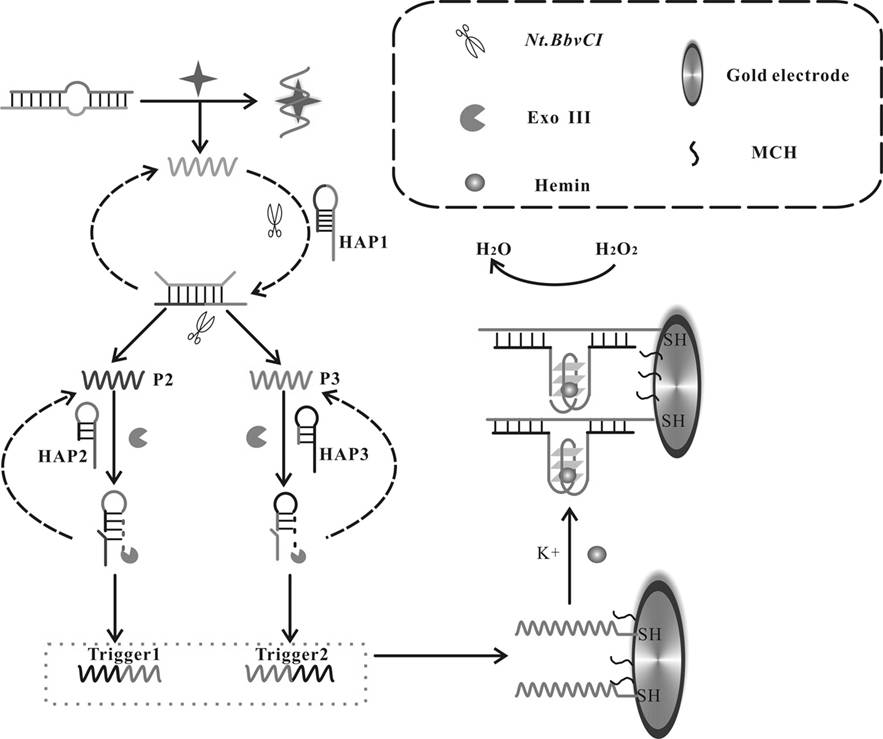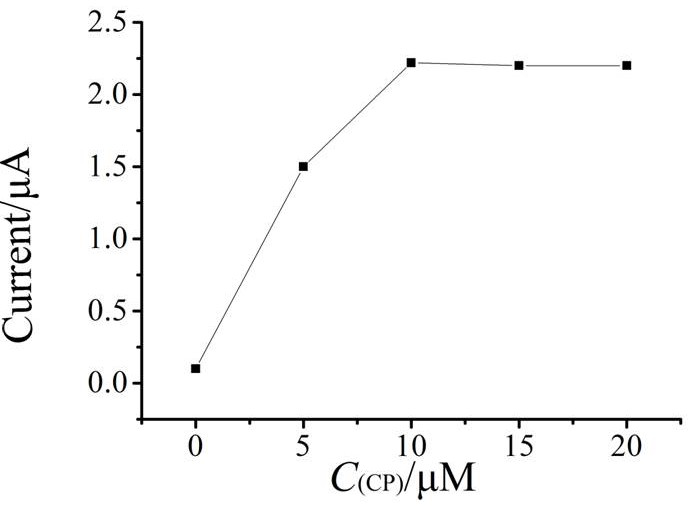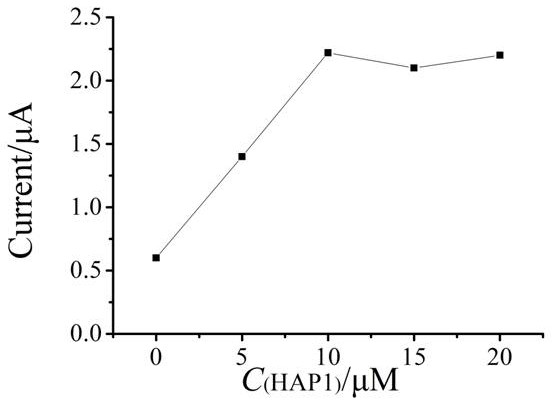An electrochemical biosensor for detecting kanamycin and its application
A biosensor, kanamycin technology, applied in the direction of material electrochemical variables, scientific instruments, instruments, etc., can solve the problems of high cost, low specificity and sensitivity, and achieve the effects of fast speed, improved sensitivity and stable performance
- Summary
- Abstract
- Description
- Claims
- Application Information
AI Technical Summary
Problems solved by technology
Method used
Image
Examples
Embodiment 1
[0056] Example 1 Preparation of a CP-modified gold electrode.
[0057] a) Gold electrode polishing treatment: the gold electrode was polished to the mirror surface in 0.3 µm and 0.05 µm alumina slurry in turn, and washed with ultrapure water for 5 times;
[0058] b) Drop 10 μL of CP solution (final concentration: 1 μM, 5 μM, 10 μM, 15 μM, 20 μM) on the surface of the above-treated gold electrode, and incubate at 37 °C for 2 hours to obtain the CP-modified gold electrode S1- S6.
Embodiment 2
[0059] Example 2 Effects of different CP concentrations on the detection of kanamycin.
[0060] (1) Hybridize Aptamer and Primer in PBS buffer to form Probe (10 μM);
[0061] (2) Probe, 10 μM HAP1, 10 μM HAP2, 10 μM HAP3, 1U / μL Nt.BbvCI endonuclease and 1U / μL exonuclease III, 10×cutsmart buffer, 5nM kanamycin standard After the solution is mixed, incubate at constant temperature;
[0062] (3) Add the mixed solution in step (2) dropwise to gold electrodes S1-S6 modified with different concentrations of CP, and then incubate at 37 °C for 2 h;
[0063] (4) Add 5 μL of heme solution (10 μM) dropwise onto the gold electrode, and then incubate at 37 °C for 1 h;
[0064] (5) Rinse the electrode in step (4) with PBS buffer solution for 3 times;
[0065] (6) containing H 2 o 2 (10 μM) PBS buffer solution, with Ag / AgCl as the reference electrode and Pt electrode as the counter electrode, the current change was measured by differential pulse voltammetry, the potential was 0 to -0.6 ...
Embodiment 3
[0067] Example 3 Effects of different HAP1 concentrations on the detection of kanamycin.
[0068] (1) Hybridize Aptamer and Primer in PBS buffer to form Probe (10 μM);
[0069] (2) Mix the probe in step (1), HAP1 (final concentration is 1 μM, 5 μM, 10 μM, 15 μM, 20 μM), 10 μM HAP2, 10 μM HAP3, 1U / μL Nt.BbvCI endonuclease and 1U / μL exonuclease III, 10× cutsmart The buffer solution and 5nM kanamycin standard solution were mixed and then incubated at a constant temperature of 37°C;
[0070] (3) Add the mixed solution in step (2) dropwise onto the CP-modified gold electrode S4, and then incubate at a constant temperature of 37 °C for 2 h;
[0071] (4) Add 5 μL of heme solution (10 μM) dropwise onto the electrode obtained in step (3), and then incubate at 37 °C for 1 h;
[0072] (5) Rinse the electrode in step (4) with PBS buffer solution for 3 times;
[0073] (6) containing H 2 o 2 (10 μM) PBS buffer solution, with Ag / AgCl as the reference electrode and Pt electrode as the ...
PUM
 Login to View More
Login to View More Abstract
Description
Claims
Application Information
 Login to View More
Login to View More - R&D
- Intellectual Property
- Life Sciences
- Materials
- Tech Scout
- Unparalleled Data Quality
- Higher Quality Content
- 60% Fewer Hallucinations
Browse by: Latest US Patents, China's latest patents, Technical Efficacy Thesaurus, Application Domain, Technology Topic, Popular Technical Reports.
© 2025 PatSnap. All rights reserved.Legal|Privacy policy|Modern Slavery Act Transparency Statement|Sitemap|About US| Contact US: help@patsnap.com



